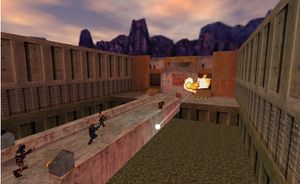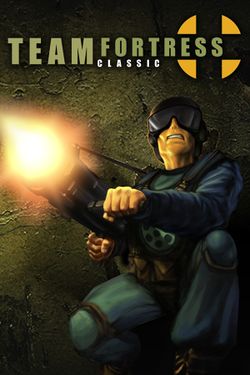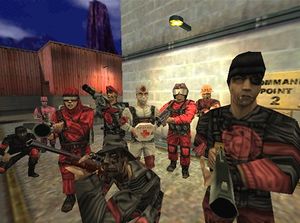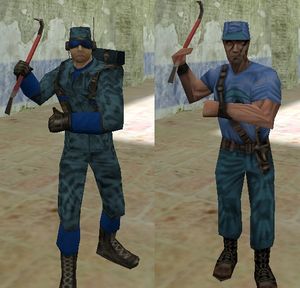Team Fortress Classic
| Tätä sivua ollaan kääntämässä suomeksi. Jos pystyt puhumaan suomea, kirjoita keskustelusivulle tai puhu niille jotka ovat parantaneet sivua (katsomalla sivuhistoriaa). |
Team Fortress Classic (TFC), tunnetaan myös Team Fortress 1.5, on yksi nimikkeistä Team Fortress -pelisarjassa.
Team Fortress Classic on Valve -korporaation kehittämä ja Sierra Studios -videopelijulkaisijan julkaisema hahmoluokkiin ja tiimeihin perustuva multiplayer-online -ensimmäisen persoonan räiskintävideopeli. Porrti Quake/QuakeWorld -pelin Team Fortress -modista , Team Fortress Classic oli alunperin julkaistu Windows -käyttöjärjestelmälle huhtikuun 1. päivänä vuonna 1999 modina Half-Life -peliin ja perustuen Half-Life 1 -videopelin pelimoottoriin (Gold Source Engine). Erillinen versio julkaistiin myöhemmin tammikuun 1. päivänä vuonna 2003. Team Fortress Classic videopelin kehitystä johti John Cook ja Robin Walker, kaksi kolmesta Team Fortress videopelin suunnittelijasta.
Peli itsessään sisältää tiimejä, missä jokaisessa on kymmenen hahmoluokkaa, jotka kilpailevat erillaisissa pelimoodeissa, kuten Lipunryöstö -, Kontrolloi pistettä -, ja Suojelu -pelimoodeissa. Kesäkuussa vuonna 2000, peli koki huomattavan parannuksen, missä peliin lisättiin uusia pelattavia hahmoja ja pelimoodeja. Vuodesta 2003 lähtien, peli oli yksi eniten pelatuista Half-Life -modeista Gamespy -mediayhtiön mukaan.[1] Nykyään, tämän edeltäjän Quake Team Fortress -videopelin kanssa, peli ei ole enää niin aktiivinen ja tämän seurauksena pelissä on enää muutamia palvelimia toiminassa, joissa ihmisä on pelaamassa bottien sijaan enemistössä. Palvelinselaimesi voi enimmillään löytää 100 palvelinta tai enemmän.
Sisällysluettelo
Kehitys
Ennen Team Fortress Classic -videopeliä oli Team Fortress – vuoden 1996 modi Quake/QuakeWorld -pelille. Sen menestymisen jälkeen, Team Fortress Software halusi aloittaa tehdä Team Fortress 2 -modia, joka perustuisi Quake II -pelimoottoriin, mutta tämä myöhemmin liittyi Valve -korporaatioon ja portitti Team Fortress -modin Half-Life -videopeliin Team Fortress Classic nimikkeellä, joka julkaistiin huhtikuun 1. päivänä vuonna 1999. Huolimatta yhtiön lausunnosta vuonna 1998, että Team Fortress 2: Brotherhood of Arms julkaistaisiin "pian", peli pysyi kehityksessä kahdeksan vuotta, kunnes se lopulta julkaistiin lokakuun 10. päivänä vuonna 2007, josta lähtien se on ollut Wired -lehden kymmenen parhaan vaporware -listan kärjessä joka vuosi 2001 -vuodesta lähtien. Team Fortress -videopelin suunnittelijoiden tehtävän oli ollut kehittää Team Fortress 2 Half-Life 1 -pelimoottorille (Gold Source Engine), mutta sen sijaan, he loivat Team Fortress -videopelin uudelleen käyttäen tätä pelimoottoria esitelläkseen sen modattavuutta.
Team Fortress Classic' -videopelin julkaisusta lähtien vuonna 1999, Valve on lisännyt useita muutoksia peliin. Päivitykset korjasivat pelin automaattista tasapainotusta ja lisäsi uutta materiaalia, kuten uusia tasoja. Erityisen iso päivitys julkaistiin kesäkuun 8. päivänä vuonna 2000, jonka mukana tuli useita uusia tasoja ja pelimoodeja, kuten uusi GUI -valikko, uusia pelattavia hahmoja ja optimisoi pelin nettikoodausta sulavemman ja nopeamman pelattavuuden saavuttamiseksi.
Gameplay
Team Fortress Classic revolves around two or more teams competing in a variety of game modes with players typically selecting one of ten classes. Players usually have the choice of two equal teams, Red and Blue, although certain game modes allow for more than two teams with access to different classes. The way a player acts in a game is defined by which class they select, with each class having their own strengths and weaknesses. As such, Team Fortress Classic relies heavily on teamwork between players of different classes.
Game modes
Team Fortress Classic supports several types of play, with distinct objectives for teams of players to pursue.

Capture the Flag
On Capture the Flag maps, the objective for both teams is to capture the enemy flag and return it to their base while preventing the opposing team from doing the same. Some maps of this type have twists on this formula, such as having multiple flags and requiring a team to capture them all or requiring a team to perform a task such as disabling security grids before being able to access the flag.
Standard
Standard maps have both teams trying to capture the enemy's flag until the point limit is reached or the time-limit expires. They must prevent their enemy from achieving the same.
Football
Football maps feature a common flag, or in most cases ball, that has to be pushed onto an enemy capture point.
Reverse
Reverse maps have the opposing teams bringing their flag to the enemy base and then capturing the flag in the enemy base.
Variant
Variant maps feature limitless possibilities. Official maps of this typology feature multiple common flags that are centrally located, as on Flagrun, or a match that takes place for each team entirely within the enemy base, as on Rock 2.
Control Point
Control Point maps have two main types of game modes.
Standard
Standard maps consist of several command points that must be captured, typically either by standing on the command point or bringing a flag to the command point. Teams are awarded points at set intervals for each command point they control.
Attack and Defend
Attack and Defend maps, a variation of Control Point maps, features one team trying to capture several command points in sequence while the other team defends each command point from capture.
Escort
In Escort maps, the players are split into three teams – a single VIP, the VIP's Bodyguards, and a group of Assassins. The goal of Escort maps is for the Bodyguards to escort the VIP to a given point on the map while the Assassins attempt to kill the VIP before he gets there.
Community-made
In addition to the official game modes released by Valve, community-made maps can create new modes of play. For example, Murderball features a King of the Hill-style game featuring a common ball in which points are tabulated by keeping the ball for as long as possible while the three other teams try to take it from you.
Classes
There are ten standard classes in Team Fortress Classic. Each class is equipped with at least one unique weapon, and often armed with a secondary weapon such as the Shotgun or Nailgun. In addition, all classes are armed with a melee weapon – usually the Crowbar – as well as Grenades that have a variety of effects depending on the class the player has chosen. On Escort maps, a single player can assume the role of the Civilian, armed only with an umbrella, who must be escorted by the rest of the team across the level.
The Scout is the fastest class in the game, but is unable to take much damage in return. The Scout is armed with a nailgun as well as being able to use caltrops and concussion grenades to slow down and confuse opponents.
The Sniper class is armed with a high-powered Sniper Rifle, and can be used to attack enemies from distant positions.
Soldiers are significantly slower than Snipers and Scouts, but possess better armor and are armed with rocket launchers that allow them to rocket jump, along with combat shotguns as sidearms for backup. Rocket jumping, while effective for moving about the battlefield, also significantly damages the Soldier. Soldiers can also make use of nail bombs to cause more damage within close quarters.
The Demoman is armed with a Grenade Launcher for indirect fire onto enemy positions, and a Pipe Bomb launcher for booby trapping places as well as being equipped with a demolition pack capable of opening or closing certain routes on some levels.
The Medic is equipped with a super nail gun, concussion grenades and a medical kit that can be used either to heal teammates or expose opponents to a contagious infection that drains health.
The Heavy weapons class is armed with a powerful Minigun, and can sustain more damage than any other class. However, the heavy is significantly slower than other classes.
Pyros are equipped with a Flamethrower and an incendiary Rocket Launcher, both of which can set enemies on fire. The Pyro also carries several napalm grenades for the same purpose.
The Spy differs significantly in style from other classes, with the class possessing the ability to take on the appearance of any other class on either side. The Spy is equipped with a knife to kill enemy players in one hit by stabbing them in the back as well as a tranquilizer gun to slow down opponents and hallucination gas to confuse them. Spies also possess the ability to feign death, allowing them to use their backstab ability more effectively.
The final class is the Engineer. A defensive class, Engineers build structures to support their team, such as Sentry Guns to defend key points, ammunition Dispensers and a teleporter. Engineers have the ability to replenish a teammate's armour by tapping them with their spanner. In addition, the Engineer is armed with EMP grenades that detonates any explosive ammunition within its range, as well as a Shotgun for backup.
Maps
Trivia
- On the original page for the Engineer Update, a screenshot of the original Team Fortress Classic class models, as well as a young Dell Conagher standing next to the Engineer from Team Fortress Classic, can be seen. This, as well as the Sniper's Civilian bobblehead having the Team Fortress Classic logo on its base and the Catch-Up comic confirm that Team Fortress Classic and Team Fortress 2 take place in the same universe, with TFC taking place in the 1930s.
- Unlike Team Fortress 2, Team Fortress Classic contains several references (and re-used content) from Half-Life, the most striking of which was the Hunted map. Instead of being a remake of the original Hunted President from Team Fortress, it was a conversion of a segment of the Half-Life campaign which involved navigating past several Sniper nests. No such official content has been made for Team Fortress 2, and in fact one map shares a name with the original Half-Life Deathmatch map, but has otherwise nothing in common.
- Fortress Forever was created to port the gameplay and mechanics of Team Fortress Classic over to the Source Engine and give the owners of Source games the ability to experience the Half-Life 1 Engine (Gold Source Engine) Classic. It is the most popular mod fulfilling this function as of yet, but gameplay and mechanics are slightly different from the original.
- On August 24, Team Fortress' birthday, grenades will be replaced with presents if the
tfc_birthdaycvar is set to '1'. - In the Team Fortress 2 comic, A Cold Day in Hell, the Classic Team is sent out to capture the TF2 Team.
History of Team Fortress Classic
- April 4, 1997 - Team Fortress Software formed.
- May 30, 1999 - Version released as a mod to Half-Life and based on the Half-Life 1 Engine (Gold Source Engine).
- June 8, 2000 - Version released with several new maps and game modes, a new GUI menu interface, new player models, and optimization of the game's netcoding for smoother, faster play.
- January 16, 2003 - Version released as a standalone video game and Ravelin map added.
- July 15, 2009 – Version currently released.
See also
References
External links
- Team Fortress Classic – Wikipedia's Team Fortress Classic article
- Team Fortress Classic on Steam
- Team Fortress Classic website
| |||||||||||




